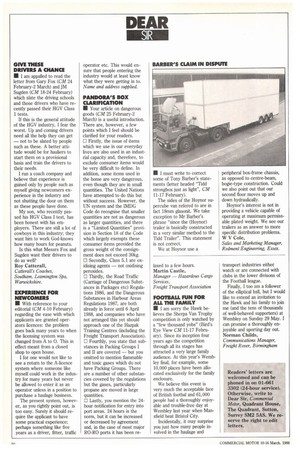DEAR
Page 60

If you've noticed an error in this article please click here to report it so we can fix it.
SIR
DRIVERS A CHANCE • I am appalled to read the letter from Gary Fox (CM 24 February-2 March) and JM Sugden (CM 18-24 February) which slate the driving schools and those drivers who have recently passed their HGV Class 1 tests.
If this is the general attitude of the HGV industry, I fear the worst. Up and coming drivers need all the help they can get — not to be slated by people such as these. A better attitude would be for hauliers to start them on a provisional basis and train the drivers to their needs.
I run a coach company and believe that experience is gained only by people such as myself giving newcomers experience in the industry and not shutting the door on them as these people have done.
My son, who recently passed his HGV Class I test, has been honest with his employers. There are still a lot of cowboys in this industry; they want him to work God-knows how many hours for peanuts.
Is this what Messrs Fox and Sugden want their drivers to do as well?
Roy Catterall, Catterall's Coaches, Southam, Leamington Spa, Warwickshire.
• With reference to your editorial (CM 4-10 February) regarding the ease with which applicants are granted operators licences: the problem goes back many years to when the licensing system was changed from A to 0. This in effect meant from a closed shop to open house.
I for one would not like to see a return to the A-licence system where someone like myself could work in the industry for many years but never be allowed to enter it as an operator unless in a position to purchase a haulage business.
The present system, however, as you rightly point out, is too easy. Surely it should require the applicant to have some practical experience; perhaps something like five years as a driver, fitter, traffic operator etc. This would ensure that people entering the industry would at least know what they were getting in to. Name and address supplied.
• Your article on dangerous goods (CM 25 February-2 March) is a useful introduction. There are, however, a few points which I feel should be clarified for your readers.
O Firstly, the issue of items which we use in our everyday lives are also used in an industrial capacity and, therefore, to exclude consumer items would be very difficult to define. In addition, some items used in the home are very dangerous, even though they are in small quantities. The United Nations have attempted to do this but without success. However, the UN system and the IMDG Code do recognise that smaller quantities are not as dangerous as larger quantities, and there is a "Limited Quantities" provision in Section 18 of the Code which largely exempts these consumer items provided the gross weight of the consignment does not exceed 30kg.
O Secondly, Class 5.1 are oxidising agents — not oxidising peroxides. o Thirdly, the Road Traffic (Carriage of Dangerous Substances in Packages etc) Regulations 1986, and the Dangerous Substances in Harbour Areas Regulations 1987, are both already in force until 6 April 1988, and companies who have not arranged this yet should approach one of the Hazpak Training Centres (including the Freight Transport Association). 0 Fourthly, you state that substances in Packing Groups I and II are covered — but you omitted to mention flammable and toxic gases which do not have Packing Groups. There are a number of other substancies covered by the regulations but the gases, particularly propane are moved in large quantities. o Lastly, you mention the 24hour notification for entry into port areas. 24 hours is the norm, but it can be increased or decreased by agreement and, in the case of most major RO-RO ports it has been re • I must write to correct some of Tony Barber's statements (letter headed "Tidd strongbox just as light", CM 11-17 February).
The sides of the Hoynor supercube van refered to are in fact 18rnm glasonit. We take exception to Mr Barber's phrase "since the (Hoynor) trailer is basically constructed in a very similar method to the Tidd Trailer". This statement is not correct.
We at Hoynor use a FOOTBALL FUN FOR ALL THE FAMILY • I am sorry the Hawk believes the Sherpa Van Trophy competition is only watched by a "few thousand yobs" (Bird's Eye View CM 11-17 February). Since its inception four years ago the competition through all its stages has attracted a very large family audience. At this year's Wembley final, for example, some 10,000 places have been allocated exclusively for the family enclosure.
We believe this event is very much the acceptable face of British footbal and 61,000 people had a thoroughly enjoyable and trouble-free day at Wembley last year when Mansfield beat Bristol City.
Incidentally, it may surprise you just how many people involved in the haulage and peripheral box-frame chassis, as opposed to centre-beam, bogie-type construction. Could we also point out that our second floor moves up and down hydraulically.
Hoynor's interest is not in providing a vehicle capable of operating at maximum perrnissable plated weight. We see our trailers as an answer to more specific distribution problems. W V Cole, Sales and Marketing Manager, Redment Engineenng, Essex.
transport industries either watch or are connected with clubs in the lower divisons of the Football league.
Finally, I too am a follower of the elliptical ball, but I would like to extend an invitation to the Hawk and his family to join me (and the tens of thousands of well-behaved supporters) at Wembley on Sunday 29 May. I can promise a thoroughly enjoyable and sporting day out. Norman Childs, Communications Manager, Freight Rover, Birmingham








































































































